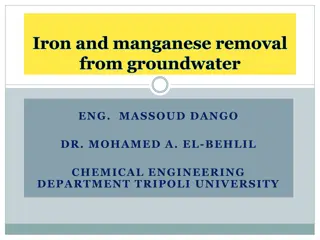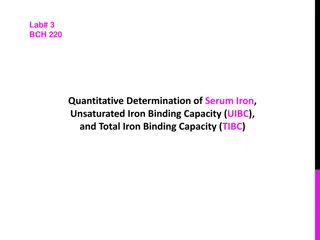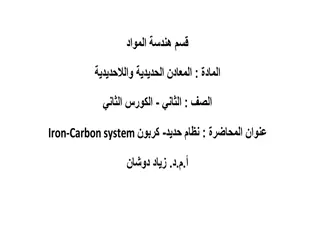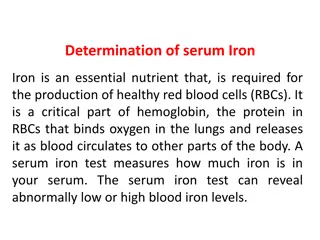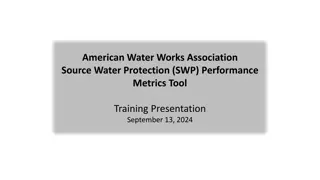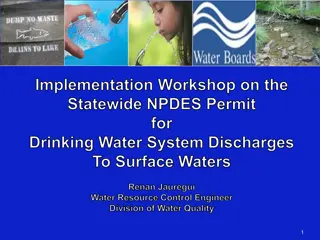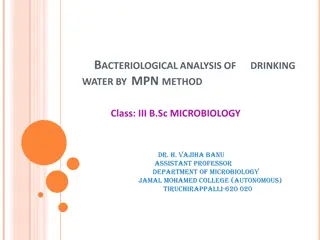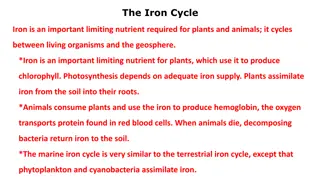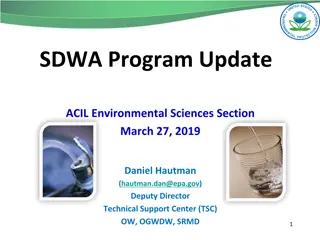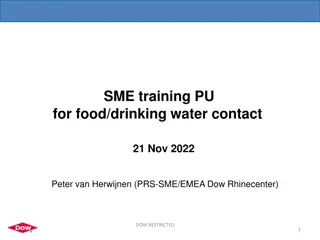Iron & Manganese Optimization Strategies for Drinking Water Systems
Explore the importance of optimizing iron and manganese levels in drinking water systems through effective treatment strategies, monitoring, and compliance with EPA standards. Learn about the sources of iron and manganese, their physical states, oxidation states, and the benefits of optimization in improving water quality and infrastructure longevity.
Download Presentation

Please find below an Image/Link to download the presentation.
The content on the website is provided AS IS for your information and personal use only. It may not be sold, licensed, or shared on other websites without obtaining consent from the author. Download presentation by click this link. If you encounter any issues during the download, it is possible that the publisher has removed the file from their server.
E N D
Presentation Transcript
National AWOP 9th Biennial Virtual Event July 19-21 Iron & Manganese Optimization Presented by: Clayton Nicolardi, P.E.
Presentation Outline I. II. III. Basic Chemistry IV. Treatment Strategies a. Removal b. Sequestration V. Assessing Treatment Effectiveness a. Monitoring b. Sampling Standards/Goals Sources 2
Drinking Water Standards The EPA has established secondary constituent levels (SCL) for iron and manganese of 0.30 and 0.05 mg/L, respectively In 2004, they also set a non- enforceable lifetime health advisory (HA) level of 0.3 mg/L for chronic exposure to manganese and a 1-day and 10-day HA of 1.0 mg/L for acute exposure. 3
Optimization Goals 0.10 mg/L iron 0.02 mg/L manganese Your optimization goals may be more stringent 4
Optimization Why optimize? o Many water systems will begin to have problems before levels reach secondary levels o Reduce discolored water complaints o Improve corrosion control treatment o Improve disinfection residuals by reducing demand o Increase longevity of infrastructure by reducing scale 5
Sources of Iron and Manganese Groundwater o Aquifers pick up increased levels of iron and manganese as water filters through soils containing them in the recharge areas. Surface Water (Lakes and Rivers) o Iron and manganese wash into impoundments from the watershed increasing in concentration over time. 6
Physical States of Iron and Manganese Soluble (in solution) Insoluble Fraction that can be filtered Colloidal For removal through sedimentation or filtration we need to oxidize soluble iron and manganese to their insoluble forms. 7
Oxidation States Iron (Fe): Fe+2 Ferrous (soluble) Fe+3 Ferric (insoluble) ferric oxides (Fe2O3) Manganese (Mn): Mn+2 Manganous (soluble) Mn+3 Manganic (insoluble) Mn+4 (insoluble) manganese dioxide (MnO2) 8
Oxidation Reactions Fe+0 Fe+2 + 2e- Oxidation Fe+2 Fe+3 + 1e- Oxidation Mn+0 Mn+2 + 2e- Oxidation Mn+2 Mn+3 + 1e- Oxidation Mn+3 Mn+4 + 1e- 9 Oxidation
Forms in Source Water Groundwater o Iron and manganese are in the soluble form as groundwater is void of oxygen. Surface Water o Iron and manganese can be in the soluble or insoluble form depending on whether they are exposed to oxygen or CO2. 10
Pretreatment Oxidation Chlorine Permanganates (sodium/potassium) Chlorine dioxide Ozone Aeration (non-chemical) pH Adjustment Caustic Lime 11
Chemical Oxidation Chemical oxidants can be used to either: Oxidize soluble iron and manganese to their insoluble forms; Recharge/restore adsorption properties of filter media (e.g. KNMnO4 for greensand and chlorine for microsand); or Both 12
Aeration Aeration can be used to: Oxidize soluble iron (not so practical for oxidizing soluble manganese) Help remove demand such as hydrogen sulfide Increase pH by removing carbon dioxide 13
De-stratification Colder Temperatures O2 O2 Oxidation Colder Water Oxic Layer Mn4+ Fe3+ Fe2+ Mn2+ Warmer Water Anoxic Layer Reduction CO2 CO2 15
pH Adjustment Improve coagulation Optimize oxidation of iron (lower pH) and manganese (higher pH) Achieve optimum pH for coagulants and organic polymers Achieve optimum pH for hydrogen sulfide removal and oxidation of iron and manganese Facilitate softening 16
Filter Media Types Dual media (anthracite/sand) Manganese greensand (Burgess Iron Removal Method) Birm Anthrasand Pyrolusite 17
Sequestration Sequestration does not remove iron and manganese - only keeps them in solution (Fe+2 and Mn+2) The objective of sequestration is to keep prevent soluble iron and manganese from oxidizing 18
How it Works 19
Sequestrants Polyphosphates: Sodium acid pyrophosphate Tetrasodium pyrophosphate Tetrapotassium pyrophosphate Sodium tripolyphosphate Potassium tripolyphosphate Sodium trimetaphosphate and Sodium hexametaphosphate 20
Chemical Effectiveness Adequate mixing Need adequate chemical dispersion before adding oxidant Location of feeding point Should be as close to the raw source as possibly and always before the chlorine feed Temperature Water temperatures above 120 F can lead to the dissociation of sequestering complexes (e.g. water heaters) o o o 21
Chemical Effectiveness pH o Each sequestering agent has an optimum pH range and it s highly recommended to follow it. Reaction time o Time is needed to allow the chemical to work. Water age o Sequestering agents are usually reliable for approximately 3 to 5 days depending on temperature. 22
Chemical Effectiveness Hardness (Calcium Ca2+ and Magnesium Mg2+) Moderately to high water hardness significantly limits the effectiveness of polyphosphates. Dosage control (normally 1-3 ppm) unless high hardness Concentration of iron and manganese (when combined concentrations are above 1 ppm, sequestering not usually effective). o 23
Where to Feed Sequestering Agent? Polyphosphate Polyphosphate EP001 Well Mixer Chlorine Chlorine Distribution 24
Profile (Aeration and Filtration) 1. 2. 3. Dissolved O2 Total Fe & Mn Soluble/Insoluble Fe & Mn pH Dissolved O2 Total Fe & Mn Soluble/Insoluble Fe & Mn pH FCL Total Fe & Mn Soluble/Insoluble Fe & Mn FCL 4-6. Total Fe & Mn Soluble/Insoluble Fe & Mn FCL Aerator 4 1 2 3 EP001 Filter Well Chlorine Distribution 6 5 Sample Location 25
Profile (KMnO4 & Filtration) 1. 4-6. 3. 2. Total Fe & Mn Soluble/Insoluble Fe & Mn pH Total Fe & Mn Soluble/Insoluble Fe & Mn FCL Total Fe & Mn Soluble/Insoluble Fe & Mn Total Fe & Mn Soluble/Insoluble Fe & Mn pH 4 1 3 2 EP001 Filter Well Chlorine KMnO4 Note: conduct drawdown test to determine dosage of KMnO4. Also, need well flow rate. Distribution 6 5 Sample Location 26
Profile Surface Water Treatment 4-6. Total Fe & Mn Soluble/Insoluble Fe & Mn TCL pH 3. Total Fe & Mn Soluble/Insoluble Fe & Mn pH Chlorine Filters 2 1 Clarifier LAS Caustic KMnO4 Alum 3 Distribution EP001 5 1. 2. 4 Total Fe & Mn Soluble/Insoluble Fe & Mn pH Total Fe & Mn Soluble/Insoluble Fe & Mn pH 27
Manganese Interference with Chlorine Residual Measurements Matthew T. Alexander, P.E. Office of Ground Water and Drinking Water Standards and Risk Management Division Technical Support Center, Cincinnati, OH
Disclaimer The information in this presentation has been reviewed and approved for public dissemination in accordance with U.S. Environmental Protection Agency (EPA). The views expressed in this presentation are those of the author(s) and do not necessarily represent the views or policies of the Agency. Any mention of trade names or commercial products does not constitute EPA endorsement or recommendation for use. U.S. Environmental Protection Agency 29
Outline Why is Manganese a Concern? Case Studies Approaches to Minimize Interference with Chlorine Analysis U.S. Environmental Protection Agency 30
Why is Manganese a Concern? In 2004, EPA issued a Drinking Water Health Advisory for manganese (Mn): A secondary maximum contaminant level (SMCL) of 0.050 mg/L based on aesthetic considerations; A chronic (lifetime) health advisory (HA) level of 0.3 mg/L; An acute 10-day HA value for infants younger than 6 months of 0.3 mg/L; and An acute 1-day and 10-day HA value for adults and children older than 6 months of 1.0 mg/L. Manganese was included in UCMR4, and a summary of occurrence data may be found here: https://www.epa.gov/sites/production/files/2018- 10/documents/ucmr4-data-summary.pdf U.S. Environmental Protection Agency 31
Why is Manganese a Concern? Manganese can exist in various oxidative states, where chemical and physical properties can vary substantially (e.g., solubility, color). Insoluble forms of manganese can result in aesthetic issues, even at concentrations below the SMCL, leading to customer complaints and lack of consumer confidence. Oxidized forms of manganese (Mn3+, Mn4+, Mn7+) are also positive interferences with N,N-diethyl-p-phenylenediamine (DPD) chlorine methods, which could result in biased high measurements of disinfectant residual. U.S. Environmental Protection Agency 32
Interference with DPD Chlorine Methods DPD chlorine methods are based on chemical redox (oxidation-reduction) reactions that form a pink color when chlorine or other oxidants react with DPD reagent in solution. The intensity of the color is a function of the total oxidizing capacity of the sample, which includes interferents such as: Other Disinfectants chlorine dioxide, inorganic chloramines, ozone, bromine, hydrogen peroxide Disinfection Byproducts chlorate, chlorite, bromate, and others? Organic Chloramines formed when chlorine reacts with organic nitrogen compounds to form amines, amino acids, and other compounds Oxidized Metals chromium (Cr6+), manganese (Mn+3 to Mn+7) U.S. Environmental Protection Agency 33
Case Study #1 Idaho GW System Data from distribution system (DS) optimization workshop during Region 10 AWOP meeting DS Entry Point (EP) Chlorine data was difficult to interpret DS concentrations were greater than EP residual ( 1.0 mg/L) Residuals at some remote locations was unexplainably high Indophenol method was also used at a few locations (data not shown) and DPD method was up to 0.4 mg/L greater U.S. Environmental Protection Agency 34
Case Study #1 Idaho GW System Idaho staff and water system conducted follow-up sampling based on workshop results Monitored manganese and free chlorine using both DPD and indophenol methods Additional data suggested that manganese could be interfering with DPD free chlorine measurements Free Cl2 Method Difference (mg/L) Total Mn (mg/L) DPD Free Cl2 (mg/L) Indophenol Free Cl2 (mg/L) Percent Difference (%) Site A 0.265 1.14 0.47 0.67 143 B 0.256 0.90 0.23 0.67 291 C 1.54 0.60 0.15 0.45 297 D 0.692 1.24 0.32 0.92 286 U.S. Environmental Protection Agency 35
Case Study #2 New Mexico GW System System triggered Level 1 Assessment under the Revised Total Coliform Rule. Abnormally high free chlorine residual was found in the DS during the Level 1 Assessment Measured residual from hydrant at remote DS location was 10x greater than EP Free chlorine measurements were higher at locations with discolored water Free Chlorine Residual (mg/L) DPD Method Sample Location August 21st August 22nd August 23rd Entry Point 0.73 - 0.63 Site #5 - 0.37 0.19 Increasing Water Age TCR #027 0.08 0.65 - TCR #009 0.01 0.11 - Site #11 - 0.08 Site #7 - 0.22 Hydrant near end of DS 6.9 6.6 - U.S. Environmental Protection Agency 36
Suspended Mn (mg/L) Dissolved Mn (mg/L) Total Mn (mg/L) DPD Total Cl2 (mg/L) DPD Free Cl2 (mg/L) Indophenol Free Cl2 (mg/L) Case Study #2 Sample Location Follow-up study was conducted a few weeks later System conducted extensive flushing since prior site visit Compared free chlorine residual from DPD and indophenol methods Measured dissolved, suspended, and total Mn Data suggests that Mn was interfering with DPD measurements Indophenol method suggests inadequate disinfection residual at EP and some DS locations Raw 0.04 0.84 0.88 - - - Treated (EP) 0.03 0.00 0.03 0.60 0.46 0.14 Increasing Water Age Site #5 0.07 0.01 0.08 0.32 0.23 0.09 TCR #027 0.22 0.07 0.29 0.23 0.18 0.17 TCR #009 0.01 0.00 0.01 0.04 0.11 0.00 Site #11 0.09 0.01 0.10 0.14 0.13 0.10 Site #7 0.24 0.01 0.25 0.37 0.27 0.00 Hydrant 0.30 0.01 0.31 0.62 0.27 0.00 U.S. Environmental Protection Agency 37
Approaches to Minimize Interference with Chlorine Analysis: Pre-Treat Sample Interference from manganese may be minimized by a blank correction (see S.M. 4500-Cl F1d): Sample is dechlorinated with sodium arsenite, which does not react with manganese. The dechlorinated sample is then analyzed using the DPD method procedure. The result from the dechlorinated sample (i.e., manganese interference) is then subtracted from the result of a non-dechlorinated sample. A step-by-step procedure to pre-treat a sample is also summarized in DPD chlorine method summaries provided by manufacturers (e.g., Hach Methods 8021 and 8167). Sample waste containing sodium arsenite must be disposed of in accordance with local, state, and federal regulations. U.S. Environmental Protection Agency 38
Approaches to Minimize Interference with Chlorine Analysis: Use Indophenol Method Indophenol free chlorine method was approved by EPA for the determination of free chlorine in drinking water in July 2016. Unlike DPD methods, indophenol chemistry is not susceptible to interference from manganese and many other compounds. Does not require sample pre-treatment with sodium arsenite and resulting hazardous waste. Relatively longer sample reaction time than DPD methods. U.S. Environmental Protection Agency 39
Summary In addition to potential health issues associated with consuming elevated levels of manganese, it can indirectly cause other public health issues associated overquantifying disinfectant residual. Disinfectant residual may be accurately quantified in samples containing oxidized manganese by pre-treating samples or using an alternative method. Potential interferences should always be considered when measuring disinfectant residual (e.g., manganese, organic chloramines, other oxidants). U.S. Environmental Protection Agency 40
Contact Info: Matthew Alexander alexander.matthew@epa.gov 513-569-7380 41


